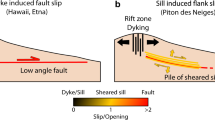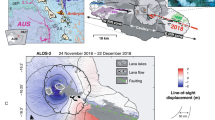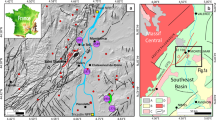Abstract
Volcanic uplift, caused by the accumulation of magma in subsurface reservoirs, is a common precursor to eruptions1,2. But, for some volcanoes, uplift of metres or more has not yet led to an eruption3. Here we present displacement maps of volcanoes in the Galápagos Islands, constructed using satellite radar interferometry, that might help explain this dichotomy. We show that all but one of the seven volcanoes on the islands of Isabela and Fernandina deformed during 1992–99. Cerro Azul and Fernandina erupted4,5,6 during the observation period and show evidence of inflation, co-eruptive deflation and shallow dyke intrusion. In contrast, the largest volcano, Sierra Negra, has not erupted, yet exhibits spatially and temporally variable deformation, with a maximum uplift of 2.7 m between 1992 and 1999, which can be modelled by a shallow inflating sill. Inflation during 1997–98, however, was accompanied by ‘trapdoor’ faulting on a steeply dipping fracture system within the caldera. Repeated trapdoor faulting over geological time has formed an arcuate intra-caldera ridge within Sierra Negra and may have acted to relax stresses above the magma chamber, inhibiting summit eruptions. Similar processes may help explain large uplift unaccompanied by eruptive activity at other volcanoes.
This is a preview of subscription content, access via your institution
Access options
Subscribe to this journal
Receive 51 print issues and online access
$199.00 per year
only $3.90 per issue
Buy this article
- Purchase on Springer Link
- Instant access to full article PDF
Prices may be subject to local taxes which are calculated during checkout





Similar content being viewed by others
References
Dvorak, J. J. & Dzurisin, D. Volcano geodesy: the search for magma reservoirs and the formation of eruptive vents. Rev. Geophys. 35, 343–384 ( 1997).
Lipman, P. W., Moore, J. G. & Swanson, D. A. Bulging of the north flank before the May 18 eruption–geodetic data. USGS Prof. Pap. 1250, 143– 155 (1981).
Newhall, C. G. & Dzurisin, D. Historical unrest at large calderas of the world. USGS Bull. 1855, 509– 520 (1988).
Naumann, T. & Geist, D. Physical volcanology and structural development of Cerro Azul Volcano, Isabela Island, Galápagos: Implication for the development of Galápagos-type shield volcanoes. Bull. Volcanol. 61, 497–514 (2000).
Mouginis-Mark, P. J., Snell, H. & Ellisor, R. GOES satellite observations of the 1998 eruption of Volcan Cerro Azul, Galápagos Islands. Bull. Volcanol. 62, 188–198 (2000).
Jónsson, S. et al. A shallow-dipping dike fed the 1995 flank eruption at Fernandina volcano, Galápagos, observed by satellite radar interferometry. Geophys. Res. Lett. 26, 1077–1080 (1999).
Geist, D., Howard, K. A., Jellinek, A. M. & Rayder, S. The volcanic history of Volcán Alcedo, Galápagos Archipelago: A case study of rhyolitic oceanic volcanism. Bull. Volcanol. 56, 243–260 (1994).
Simkin, T. & Siebert, L. Volcanoes of the World 2nd edn (Geoscience, Tucson, 1994).
Bonafede, M. & Mazzanti, M. Modelling gravity variations consistent with ground deformation in the Campi Flegrei caldera (Italy). J. Volcanol. Geotherm. Res. 81, 137– 157 (1998).
Wicks, C. Jr, Thatcher, W. & Dzurisin, D. Migration of fluids beneath Yellowstone caldera inferred from satellite radar interferometry. Science 282, 458–462 (1998).
Reynolds, R. W., Geist, D. & Kurz, M. D. Physical volcanology and structural development of Sierra Negra volcano, Isabela island, Galápagos archipelago. Geol. Soc. Am. Bull. 107, 1398–1410 (1995).
Murray, J. B. The influence of loading by lavas on the siting of volcanic eruption vents on Mt Etna. J. Volcanol. Geotherm. Res. 35, 121–139 (1988).
Briole, P., Massonnet, D. & Delacourt, C. Post-eruptive deformation associated with the 1986–87 and 1989 lava flows on Etna detected by radar interferometry. Geophys. Res. Lett. 24, 37–40 (1997).
Stevens, N. F. Surface movements of emplaced lava flows measured by SAR interferometry. J. Geophys. Res. (in the press).
Cervelli, P., Murray, M. H., Segall, P., Aoki, Y. & Kato, T. Estimating source parameters from deformation data, with an application to the March 1997 earthquake swarm off the Izu Peninsula, Japan. J. Geophys. Res. (in the press).
Mogi, K. Relations between the eruptions of various volcanoes and the deformation of the ground surface around them. Bull. Earth. Res. Inst. Univ. Tokyo 36, 99–134 ( 1958).
Geist, D., Naumann, T. & Larson, P. Evolution of Galápagos magmas: Mantle and crustal level fractionation without assimilation. J. Petrol. 39, 953–971 (1998).
Allen, J. F. & Simkin, T. Fernandina Volcano's evolved, well-mixed basalts: Mineralogical and petrological constraints on the nature of the Galápagos plume. J. Geophys. Res. 105, 6017– 6041 (2000).
Lawson, C. L. & Hanson, R. J. Solving Least Squares Problems (Prentice-Hall, Englewood Cliffs, New Jersey, 1974).
Kanamori, H. & Anderson, D. L. Theoretical basis of some empirical relations in seismology. Bull. Seismol. Soc. Am. 65 , 1073–1095 (1975).
Rowland, S., Munro, D. C. & Perez-Oviedo, V. Volcán Ecuador, Galápagos islands: erosion as a possible mechanism for the generation of steep-sided basaltic volcanoes. Bull. Volcanol. 56, 271– 283 (1994).
Massonnet, D. et al. The displacement field of the Landers earthquake mapped by radar interferometry. Nature 364, 138– 142 (1993).
Zebker, H., Rosen, P., Goldstein, R., Gabriel, A. & Werner, C. On the derivation of coseismic displacement fields using differential radar interferometry: The Landers earthquake. J. Geophys. Res. 99, 19617–19643 ( 1994).
Massonnet, D. & Feigl, K. Radar interferometry and its application to changes in the Earth's surface. Rev. Geophys. 36 , 441–500 (1998).
Mouginis-Mark, P. J., Rowland, S. K. & Garbeil, H. Slopes of western Galápagos volcanoes from airborne interferometric radar. Geophys. Res. Lett. 23, 3767–3770 (1996).
Goldstein, R. M., Zebker, H. A. & Werner, C. L. Satellite radar interferometry: Two-dimensional unwrapping. Radio Sci. 23, 713–720 (1988).
Acknowledgements
We thank the European Space Agency for providing the SAR data and for supporting F.A. with a post-doctoral fellowship. This study was also supported by NASA. We thank D. Geist and P. Lundgren for comments.
Author information
Authors and Affiliations
Additional information
Stanford University, Department of Geophysics, Mitchell Building, Stanford, California94305-2215, USA
Rights and permissions
About this article
Cite this article
Amelung, F., Jónsson, S., Zebker, H. et al. Widespread uplift and ‘trapdoor’ faulting on Galápagos volcanoes observed with radar interferometry. Nature 407, 993–996 (2000). https://doi.org/10.1038/35039604
Received:
Accepted:
Issue Date:
DOI: https://doi.org/10.1038/35039604
This article is cited by
-
Volcano geodesy using InSAR in 2020: the past and next decades
Bulletin of Volcanology (2022)
-
Land subsidence prediction using recurrent neural networks
Stochastic Environmental Research and Risk Assessment (2022)
-
Caldera resurgence during the 2018 eruption of Sierra Negra volcano, Galápagos Islands
Nature Communications (2021)
-
Three-dimensional strain descriptors at the Earth’s surface through 3D retrieved co-event displacement fields of differential interferometric synthetic aperture radar
Journal of Geodesy (2021)
-
Coeruptive and posteruptive crustal deformation associated with the 2018 Kusatsu-Shirane phreatic eruption based on PALSAR-2 time series analysis
Earth, Planets and Space (2020)
Comments
By submitting a comment you agree to abide by our Terms and Community Guidelines. If you find something abusive or that does not comply with our terms or guidelines please flag it as inappropriate.



